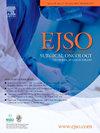eb病毒相关胃癌根治性胃切除术后的长期生存分析:一项多中心研究
IF 3.5
2区 医学
Q2 ONCOLOGY
引用次数: 0
摘要
Epstein-Barr病毒相关性胃癌(EBVaGC)的预后需要高质量的研究来验证。本研究旨在利用多中心数据评估EBVaGC患者根治性胃切除术后的长期生存,以探讨EBV感染状态作为预后预测因子的潜在价值。方法分析2013年1月至2020年7月行根治性胃切除术的EBVaGC和eb病毒阴性胃癌(EBVnGC)患者的临床资料。采用Kaplan-Meier法和Cox回归分析评价总生存期(OS)和无病生存期(DFS)。建立随机生存森林(RSF)模型预测预后。结果经倾向评分匹配后,EBVaGC组205例,EBVnGC组410例。EBVaGC组3年OS和DFS明显高于EBVnGC组。多因素分析显示,eb病毒编码小RNA阳性是OS和DFS的独立保护因素。在II期和III期EBVaGC患者中,接受≥4个化疗周期的患者3年OS明显优于接受≥4个化疗周期的患者。基于EBER状态的RSF模型在预测3年OS和DFS方面优于Cox模型和TNM分期系统。结论基于EBER状态建立的预后预测模型具有良好的临床应用价值,可为临床随访管理提供新的参考。建议II期和III期EBVaGC患者术后接受至少4个周期的化疗以提高生存率。本文章由计算机程序翻译,如有差异,请以英文原文为准。
Long-term survival analysis after radical gastrectomy for Epstein-Barr virus-associated gastric cancer: A multicenter study
Background
The prognosis of Epstein-Barr virus-associated gastric cancer (EBVaGC)needs to be validated by high-quality studies. This study aimed to assess the long-term survival of EBVaGC patients after radical gastrectomy using multicenter data to explore the potential value of EBV infection status as a prognostic predictor.
Methods
We analyzed the clinical data of patients with EBVaGC and Epstein-Barr virus-negative gastric cancer (EBVnGC) who underwent radical gastrectomy from January 2013 to July 2020. The Kaplan-Meier method and Cox regression analysis were used to evaluate overall survival (OS) and disease-free survival (DFS). A Random Survival Forest (RSF) model was constructed to predict the prognosis.
Results
After propensity score matching, 205 and 410 patients were included in the EBVaGC and EBVnGC groups, respectively. The 3-year OS and DFS rates in the EBVaGC group were significantly higher than those in the EBVnGC group. Multivariate analysis indicated that EBER(Epstein-Barr virus-encoded small RNA) positivity was an independent protective factor for OS and DFS. Among stage II and III EBVaGC patients, those receiving ≥4 cycles of chemotherapy had a 3-year OS significantly better than those receiving <4 cycles. The RSF model based on EBER status outperformed the Cox model and TNM staging system in predicting the 3-year OS and DFS.
Conclusion
The prognostic prediction model established based on the EBER status has good clinical application value and can provide a new reference for clinical follow-up management. It is recommended that patients with stage II and III EBVaGC receive at least four cycles of chemotherapy postoperatively to improve survival.
求助全文
通过发布文献求助,成功后即可免费获取论文全文。
去求助
来源期刊

Ejso
医学-外科
CiteScore
6.40
自引率
2.60%
发文量
1148
审稿时长
41 days
期刊介绍:
JSO - European Journal of Surgical Oncology ("the Journal of Cancer Surgery") is the Official Journal of the European Society of Surgical Oncology and BASO ~ the Association for Cancer Surgery.
The EJSO aims to advance surgical oncology research and practice through the publication of original research articles, review articles, editorials, debates and correspondence.
 求助内容:
求助内容: 应助结果提醒方式:
应助结果提醒方式:


